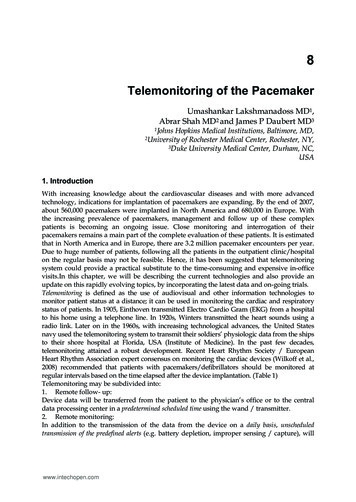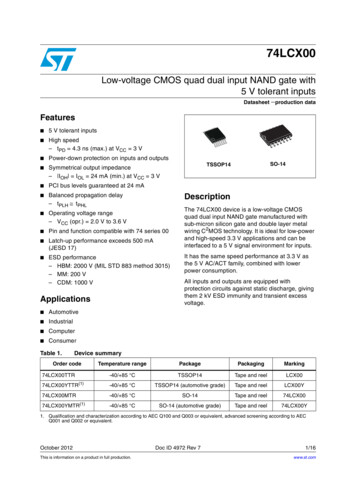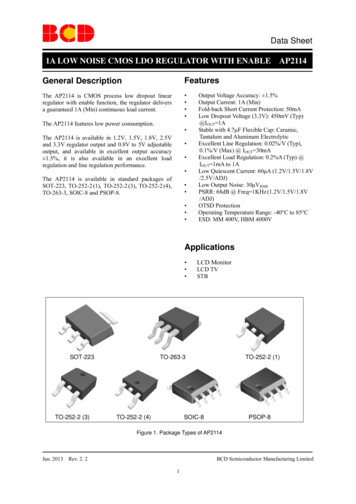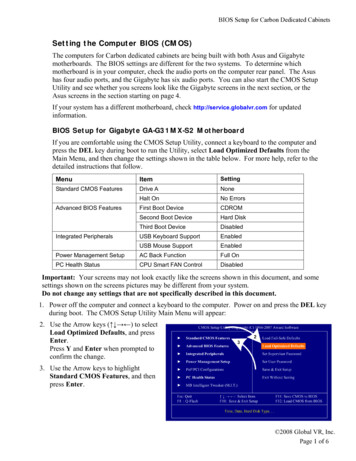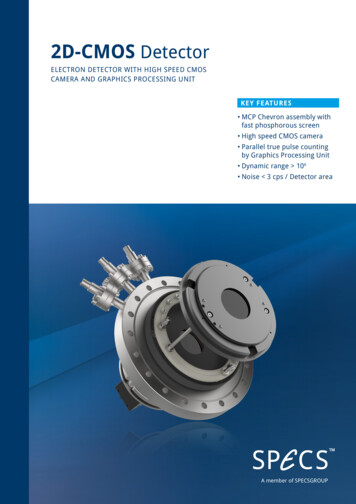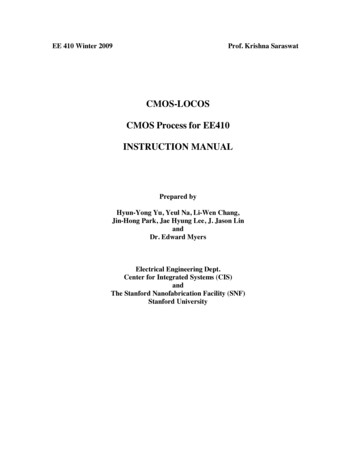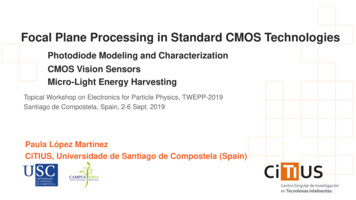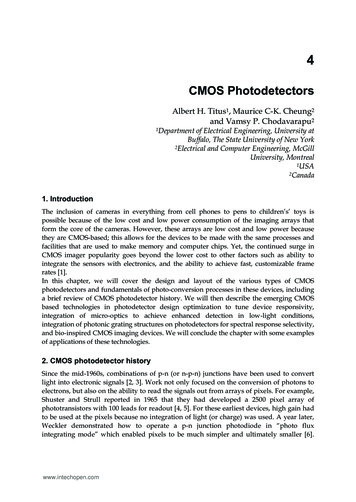
Transcription
4CMOS PhotodetectorsAlbert H. Titus1, Maurice C-K. Cheung2and Vamsy P. Chodavarapu21Departmentof Electrical Engineering, University atBuffalo, The State University of New York2Electrical and Computer Engineering, McGillUniversity, Montreal1USA2Canada1. IntroductionThe inclusion of cameras in everything from cell phones to pens to children’s’ toys ispossible because of the low cost and low power consumption of the imaging arrays thatform the core of the cameras. However, these arrays are low cost and low power becausethey are CMOS-based; this allows for the devices to be made with the same processes andfacilities that are used to make memory and computer chips. Yet, the continued surge inCMOS imager popularity goes beyond the lower cost to other factors such as ability tointegrate the sensors with electronics, and the ability to achieve fast, customizable framerates [1].In this chapter, we will cover the design and layout of the various types of CMOSphotodetectors and fundamentals of photo-conversion processes in these devices, includinga brief review of CMOS photodetector history. We will then describe the emerging CMOSbased technologies in photodetector design optimization to tune device responsivity,integration of micro-optics to achieve enhanced detection in low-light conditions,integration of photonic grating structures on photodetectors for spectral response selectivity,and bio-inspired CMOS imaging devices. We will conclude the chapter with some examplesof applications of these technologies.2. CMOS photodetector historySince the mid-1960s, combinations of p-n (or n-p-n) junctions have been used to convertlight into electronic signals [2, 3]. Work not only focused on the conversion of photons toelectrons, but also on the ability to read the signals out from arrays of pixels. For example,Shuster and Strull reported in 1965 that they had developed a 2500 pixel array ofphototransistors with 100 leads for readout [4, 5]. For these earliest devices, high gain hadto be used at the pixels because no integration of light (or charge) was used. A year later,Weckler demonstrated how to operate a p-n junction photodiode in “photo fluxintegrating mode” which enabled pixels to be much simpler and ultimately smaller [6].www.intechopen.com
66Photodiodes - World Activities in 2011Photon integration required that the photodiode be turned on for a fixed amount of timeto raise (or lower) the voltage level on a charge storage device; thus, the amount of chargeremaining (or charge that was removed) is proportional to the light intensity over thatintegration time.In the 1970s, CMOS detectors and imaging arrays began to lose popularity to ChargeCoupled Device (CCD) -based imagers because CCDs could achieve a higher fill-factor; thefill-factor was lower for CMOS imagers because of the need for transistors at the pixels forread out and gain. The ability to produce CCD imagers with the necessary number of pixelsfor applications (such as TV) gave CCDs a large advantage over CMOS imagers [7]. Noise inCCDs was also considerable less than in CMOS devices; it was generally regarded that fixedpattern noise in CMOS imaging devices was worse than in CCDs, which remained true intothe late 1980s and early 1990s. However, improvements in CMOS fabrication technologyand increasing pressure to reduce power consumption for battery operated devices beganthe re-emergence of CMOS as a viable imaging device.It is generally regarded that the first all-CMOS sensor array to produce acceptable images isthe active pixel sensor (APS) imager [8-10]. The APS design used the linear integrationmethod [6] for measuring light because of the large output signal generated, as opposed tothe logarithmic method [11-16]. The active column sensor (ACS) [17] is similar to the APSbut has lower fixed pattern noise (FPN). As of 2011, we have CMOS image sensors that have14.6 Megapixels, and higher.While CMOS and CCDs continue to compete for a share of the image array sensor market,the ability to design custom integrated circuits (ICs) with photodetectors to perform specificfunctions is an enormous advantage over CCD arrays. These ICs are often used inapplications that have specific requirements such as extremely low power consumption [18]or variable read-out (frame) rates [19] or very fast read-out rates [20]. Normal video rates of30 or 60 frames per second are fine for standard definition videos, but for some applications,frame rates of more than a thousand frames per second are needed to capture extremely fastoccurring events (for example see [20]).CMOS photodetectors are the technology of choice in smart focal plane arrays. In the mid1980s, Carver Mead and Misha Mahowald introduced the Silicon Retina that used a“vertical bipolar transistor” as the light detecting element [21]. This spawned a significantamount of research into bio-inspired vision chips that used CMOS photodetectors combinedwith CMOS signal processing circuitry [22-32]. Generally, these chips are arrays of smartpixels with significantly more transistors per pixel than the three or four found in typicalAPS-based arrays. However, the relative low cost of fabrication for prototyping CMOS ICsenables chips with one, two, dozens or thousands of detectors to be designed, fabricated andtested. For chips with few photodetectors, the remaining silicon die area can be used forsignal processing, read-out, or digital interface logic, so there is no wasted space.Applications of these custom detector and imaging chips range from sub-retinal implantimagers [33] to glare detection [34] to fluorescence imaging [35, 36] and x-ray imaging [37],to name a few. A study of three common photodiode structures available in nonimager/standard CMOS processes provides valuable benchmark data for designers lookingto use CMOS photodetectors [38]. While not an exhaustive study of all possible CMOSphotodetectors, this chapter provides a useful starting point for selecting the best structurefor the application.www.intechopen.com
67CMOS Photodetectors3. Operation of CMOS photodetectorsThe core of the sensing element of a CMOS detector is the photosensitive element of thecircuit. Photogates, phototransistors, and photodiodes all can be used as the sensingelement. In this section, the use of a photodiode is discussed. As its name implies, thephotodiode is simply a junction between a p-type and an n-type semiconductor,commonly known as a p-n junction. Although a simple p-n junction can be used for lightdetection, the more sophisticated p-i-n junction with an intrinsic region between the ptype and n-type region is often used to improve the device efficiency. In this section, thebasic working principle of a photodiode will be discussed, followed by a discussion onthe p-i-n photodiode, and a method of signal amplification resulting in the avalanchephotodiode.3.1 Photogeneration and recombination in semiconductorsWhen a semiconductor is illuminated, a photon that has higher energy, hν, than thebandgap energy, Eg, may cause an excitation of an electron from the lower energy valenceband to the higher energy conduction band. This results in a pair of the mobile chargecarriers - electrons and holes. This process known as photogeneration can occur if the totalenergy and total momentum among the photogenerated electron-hole pair and the incomingphoton is conserved.The probability of photogeneration by a single photon is a property of the material.Macroscopically, this is described by the absorption coefficient, α. As a light beampropagates through a piece of homogeneous semiconductor, its power decreasesexponentially as the semiconductor absorbs some of the power for photogeneration. Thepower that remains in the light beam after propagating through a depth of z is given by: exp[ (1)where, P0 is the intensity at zero depth. Note that the rate of absorption, dP/dz, decreasesexponentially with depth. Therefore, more photogeneration is expected to occur near thesurface.Because the photogenerated carriers exist in an excited state, the excess electrons and holeswill recombine after a short period of time ( picoseconds on average) to release the excessenergy. This process is known as recombination, and it returns the carriers distributions tothermal equilibrium condition. These excess carriers are lost if they are not captured tocreate an electrical signal for light detection. Therefore, a semiconductor device structure isneeded to facilitate the capturing of the photogenerated carriers. The simplest and mostcommonly used structure for this purpose is a diode structure known as photodiode (PD).3.2 Quantum efficiency and responsivityBefore the discussion on photodiode, two important parameters that are used tocharacterize the effectiveness of detection by a photodetector should be discussed; these arequantum efficiency and responsivity. Quantum efficiency is defined as the probability thatan incident photon will generate an electron-hole pair that will contribute to the detectionsignal, so it can be expressed as, www.intechopen.com ℛ [ exp (2)
68Photodiodes - World Activities in 2011where, ℛ is the surface reflectance, is the probability that the generated electron-hole pairwill become a contribution to the detection signal, and d is the depth of the photo-absorptionregion. Therefore, quantum efficiency is affected by material properties and device geometry.The captured carriers are used to generate a signal either as a voltage or a current. Themeasure of signal strength to incident power of the device is called responsivity. If theoutput is a current, then it is related to the quantum efficiency by the following expression, .[nm W/A](3)where, q is the electron charge and λ is the wavelength in nanometers.4. PhotodiodeMany photodetectors utilizes the formation of p-n junctions, and the simplest of these is aphotodiode, because a photodiode is simply a p-n junction that is designed for capturing thephotogenerated carriers. In CMOS sensing, a photodiode is usually made by forming an ntype region on a p-type semiconductor substrate, or vice-versa. This can be done by epitaxialgrowth, diffusion or ion implantation.4.1 A quick review of P-N junctionFigure 1 shows the carrier distributions, charge distribution, built-in electric field and banddiagram of a typical p-n junction. The inhomogeneous charge and carrier distributions arethe result of a state of equilibrium between diffusion, drift and recombination. Thefollowing is a review of the key features of a p-n junction,1. An absent of the carriers in a region known as the depletion region or space chargeregion. It has layer width, W, and ionic space charge of the donors and acceptors areexposed in this region.Fig. 1. (a) Diffusion of carriers at the p-n junction, (b) the resulting electron and hole densitydistribution, where Na and Nd are the acceptors and donors densities, (c) the resultingcharge density distribution, (d) the resulting electric field, and (e) the band diagram of a p-njunction showing the alignment of the Fermi level, Ef, and shifting of the bands. Ev is the topof the valence band and Ec and the bottom of the conduction band.www.intechopen.com
69CMOS Photodetectors2.3.Due the charge distribution, a built-in electric field, E, has emerged.Alignment of Ef between the p-type region and the n-type, as the conduction andvalance bands shift in the depletion region.There is a potential difference of V0 between the p-side and the n-side.4.4.2 Operating rincipleThe operation of a photodiode relies upon the separation of the photogenerated carriers bythe built-in field inside the depletion region of the p-n junction to create the electrical signalof detection. Under the influence of the built-in electric field, the photogenerated electronswill drift towards the n-side, and photogenerated holes will drift towards the p-side. Thephotogenerated carriers that reach the quasi-neutral region outside of the depletion layerwill generate an electric current flowing from the n-side to the p-side; this current is called aphotocurrent. The generation of the photocurrent results in the shift of the I-V characteristicof the photodiode as shown in Figure 2. Therefore, the I-V characteristic of a photodiode isexpressed as, exps (4)phwhere, the first term is the Schottky Equation that described the ideal I-V characteristicswith IS being the saturation current, k the Boltzmann constant and T the operatingtemperature, and the second term, Iph, is the photocurrent.hNPEv(a)Electric Field Ec(b)Fig. 2. Photogeneration in a p-n junction: (a) the built-in electric field driving thephotogenerated carriers from the depletion region away from the junction, and (b) shiftingof the I-V characteristic due to the photogenerated current, Iph.4.3 Basic modes of operationA photodiode can be operated in three basic modes: open circuit mode, short circuit mode,and reverse bias (or photoconductive) mode. The circuit diagrams of the three differentbasic operating modes are shown in Figure 3.Open circuit (OC) mode is also known as photovoltaic mode. As the name implies, in thismode, the terminals of the photodiode is connected an open circuit. In this mode, there is nonet current flowing across the photodiode, but due to the photogenerated current, a netwww.intechopen.com
70Photodiodes - World Activities in 2011voltage is created across the photodiode, called the open circuit voltage, VOC. In reference toFigure 2(a), the photodiode is operating at the point where the I-V characteristic curveintersects the x-axis.Fig. 3. Basic operating mode of a PD: (a) open circuit mode, (b) short circuit mode, and (c)reverse-bias mode.In contrast, in the short circuit (SC) mode, the terminal of the photodiode is short-circuited.This allows the photogenerated current to flow in a loop as illustrated in Figure 3(b). InFigure 2(b), this is represented by the point at which the I-V characteristic curve intersectsthe y-axis. The current that flows in the
imager/standard CMOS processes provides valu able benchmark data for designers looking to use CMOS photodetectors [38]. While not an exhaustive study of all possible CMOS photodetectors, this chapter provides a useful starting point for selecting the best structure for the application. www.intechopen.com. CMOS Photodetectors 67 3. Operation of CMOS photodetectors The core of


